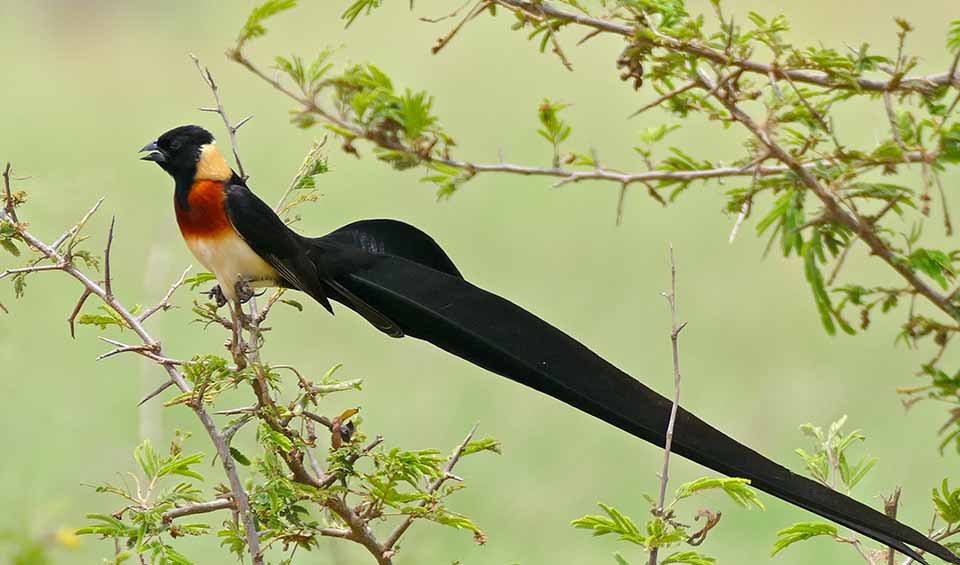One of the most spectacular and eye-catching birds of the African grasslands. Known for its incredible breeding plumage, especially the male’s extravagantly long tail, this whydah looks like a tiny bird transformed into a living ribbon during the mating season. Found widely across eastern and southern Africa, from Ethiopia and Kenya down to South Africa, the long-tailed paradise whydah thrives in open grasslands, savannas, and farmlands where its host species, typically green-winged pytilias (a type of waxbill), are also found.
During the non-breeding season, the long-tailed paradise whydah is a modest-looking little bird, with males and females both sporting sparrow-like brown and beige plumage. However, when the breeding season arrives, the male undergoes a stunning transformation. His body turns a rich, glossy black on the head, back, and breast, while the underparts become golden to chestnut-colored. But the showstopper is his tail: the male grows four incredibly long, flowing black tail feathers, often two to three times longer than his body, giving him a spectacular, almost surreal appearance in flight.
The male’s tail isn’t just for looks — it plays a vital role in courtship displays. To attract females, the male performs dramatic, slow-motion fluttering flights high above the grasslands, flaunting his enormous tail feathers while singing and mimicking the calls of his host species. His ability to manage such a long, heavy tail while maintaining graceful flight is a sign of physical fitness and genetic quality, crucial for impressing potential mates.
Distribution
 Angola
Angola Botswana
Botswana Burkina Faso
Burkina Faso Cameroon
Cameroon Chad
Chad DR Congo (Kinshasa)
DR Congo (Kinshasa) Eritrea
Eritrea Eswatini
Eswatini Ethiopia
Ethiopia Gambia
Gambia Guinea
Guinea Kenya
Kenya Malawi
Malawi Mali
Mali Mauritania
Mauritania Mozambique
Mozambique Namibia
Namibia Niger
Niger Nigeria
Nigeria Senegal
Senegal Somalia
Somalia South Africa
South Africa South Sudan
South Sudan Sudan
Sudan Tanzania
Tanzania Uganda
Uganda Zambia
Zambia Zimbabwe
ZimbabweAnything we've missed?
Help us improve this page by suggesting edits. Glory never dies!
Suggest an editGet to know me
Terrestrial / Aquatic
Altricial / Precocial
Polygamous / Monogamous
Dimorphic (size) / Monomorphic
Active: Diurnal / Nocturnal
Social behavior: Solitary / Pack / Herd
Diet: Carnivore / Granivore / Omnivore / Piscivorous / Insectivore
Migratory: Yes / No
Domesticated: Yes / No
Dangerous: Yes / No




